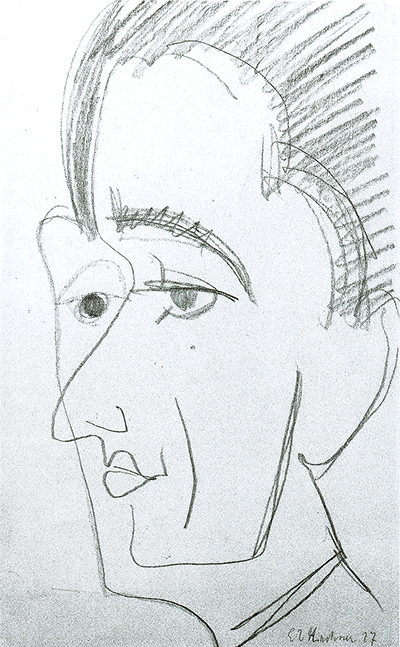Ernst Ludwig Kirchner was a keen and highly skilled draughtsman whose drawings have retained academic respect ever since his career first rose to fame. In recent decades there has been an increased focus on this medium, when previously it had always been regarded as more of a supporting technique to frescos and oil paintings.
Kirchner was a hugely prolific artist, with thousands of artworks still in existence even despite the best efforts of the ruling Third Reich to destroy as many as they could. Amongst his sketch work remains around 20,000, at the best guess, in a variety of forms of completeness. Some would be artworks in their own right, others would be in preparation for a painting or sculpture. Many of this huge collection are to be found in bound sketchbooks, some of which occasionally come up for sale at auction. A recent estimate of £150,000 - £200,000 was placed on a single sketchbook from the artist, which contained a total of 40 pieces from cover to cover. That would give a crude estimate of up to £5,000 per each individual drawing.
Many artists have found that sketchbooks have offered a portable way to capture scenes on the go, wherever their travels may take them. Most famously, William Turner would quickly put together scenes of landscapes across Europe in his small books before expanding upon them within his own studio, perhaps as a larger-scale oil painting or watercolour. Claude Monet would learn from that and do similar. Kirchner followed these same principles, though many of his drawings were actually figurative and also within his own uniquely Expressionist style.
Some quotes that have been uncovered about his career have explained just exactly how hard working and passioniate he was, and any artist would not be able to carry canvases and painting equipment with them wherever they went - this medium was the next best option. To underline just how connected he was this art form, on a daily basis, would be that a small book was actually found in his possession on the day of his passing. Whilst sadness is felt regarding the troubles that he experienced within his lifetime, he still was able to achieve so much that truly the overwhelming feeling should be of celebration at his brilliance and also that his reputation remains strong in the present day.
The German artist built up such a huge collection of work that he would often happily gift away selections of his paintings and drawings. His spell in photography also left behind thousands of negatives which would become harder and harder to store away safely and securely, whilst still accurately documented. Many of his skecthbooks were essentially just artistic diaries, where he would also place artworks alongside his thoughts of the day, even shopping lists. The key focus would always be his artistic experimentations. Close friends would sometimes be given collections of these drawings and as most of them were highly knowledgeable about art, and Kirchner's career more specifically, they would be delighted to receive personal items such as these. The artist believed these to be the purest example of his work and so was being particularly generous in giving some of these drawings away to others. They also held a great personal value to him, which hopefully the recipients would have understood at the time.
Davos in Switzerland hosts a museum dedicated to the artist. You can find a large number of photographs taken by Kirchner within its collection, as part of a wider oeuvre which touches on all the different mediums in which he was involved. One of the advantages of this artist is the huge number of artworks that he left behind, making it relatively easy to set up a large collection of his work, particularly as he also bequethed some of it to just a few recipients. That are few artists who can be covered in this way by a single institution, though the likes of Van Gogh, Rodin and Munch can be added to that relatively short list. In most cases the famous artists have their work dispersed across a large number of private and public collections, which makes it particularly hard for art fans to see many of their pieces in person, other than when an exhibition of their work comes along.
The portrait drawing that we have included in this page was entirely in pencil but Kirchner also worked in other media such as pen, ink, gouache, crayon and watercolour. He would sometimes work first in gentle touches of pencil before then working over the top once he had a rough idea of the overall layout. These approaches could be completed very quickly and without over thinking each artwork which sometimes suited the mood of the artist perfectly. He would not always want to sink a huge amount of time into a large oil painting, perhaps just seeking to expand on an idea and record it for future reference. Many other artists have used drawing as a means to doing this as well, whilst others have produced studies in order to practice particular artistic disciplines, such as accurate portraiture or to expand on a visual language before translating it into a painting. The Surrealists would work automatically, as they saw it, in order to produce drawings that were directly inspired by their own subconscious minds.




